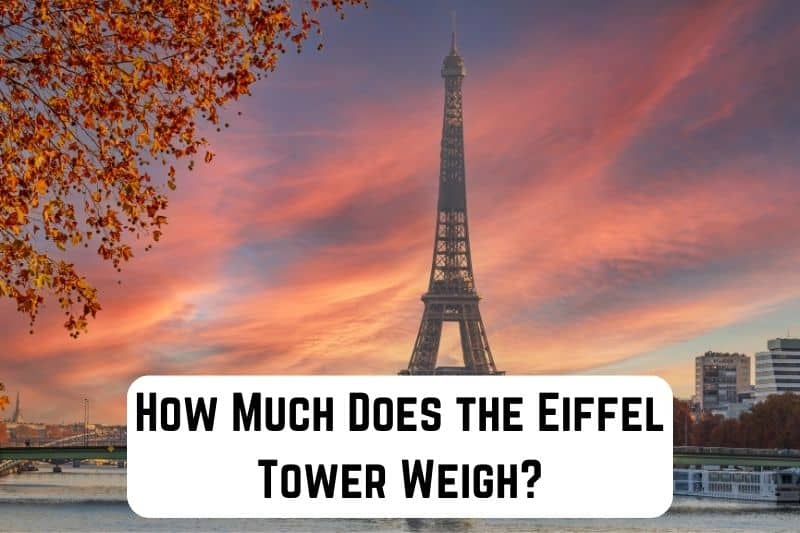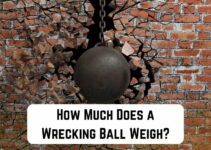Have you ever admired the iconic Eiffel Tower and wondered how much it weighs? As one of the most famous landmarks in the world, this architectural marvel has captured the hearts of millions. With its elegant design, the Eiffel Tower draws tourists from around the globe, yet few people actually know the weight behind this extraordinary structure.
Built for the 1889 World’s Fair, the Eiffel Tower is a testament to human ingenuity and the power of engineering. Comprised of iron lattice, its weight may be more than you could imagine. So, without further ado, let’s explore the fascinating answer: how much does the Eiffel Tower weigh?
Read: How Much Does a Shipping Container Weigh? (Tare & Gross Weight)
Constructed from wrought iron, Eiffel Tower weighs approximately 10,100 metric tons or 11,133 US tons or 22 million pounds. The puddle iron (wrought iron) of the Eiffel Tower weighs 7,300 tonnes. When you add the weight of shops, lifts and antennae, the total weight comes to approximately 10,100 tonnes.
History and Construction
You might be curious about the history and construction of the Eiffel Tower, an iconic and mesmerizing marvel in Paris. Let’s dive into how it all started!
History: It all began in 1889 when the Eiffel Tower was constructed to commemorate the 100th anniversary of the French Revolution. Alexandre Gustave Eiffel, the visionary civil engineer, and architect, designed this iconic monument. At that time, it was the tallest structure in the world, standing at a prodigious height of 324 meters (1,063 feet).
Construction: Building the Eiffel Tower was no easy task. It took a team of 300 workers, 18,038 pieces of iron, and 2.5 million rivets to construct this architectural marvel. Remarkably, it was completed in just over two years, from January 1887 till March 1889.
As you learn more about the Eiffel Tower, appreciating the skill and labor that went into its construction is worth appreciating. Given its age, the Eiffel Tower’s weight might surprise you: it weighs approximately 10,100 tons!

How Much Does the Eiffel Tower Weigh?
You might be surprised to learn that the Eiffel Tower, one of the most famous landmarks in the world, isn’t as heavy as you may think. Constructed from wrought iron, the Eiffel Tower weighs approximately 10,100 metric tons or 11,133 US tons or 22 million pounds.
The puddle iron (wrought iron) of the Eiffel Tower weighs 7,300 tonnes. When you add the weight of shops, lifts and antennae, the total weight comes to approximately 10,100 tonnes.
The iron used to build the Eiffel Tower was chosen for its sturdiness despite being relatively lightweight. Want to know how much iron was used? Well, it took about 18,000 pieces of iron and 2.5 million rivets to assemble this iconic structure.
It’s important to note that the Eiffel Tower has an intricate design that helps reduce its overall weight. The architect, Gustave Eiffel, focused on creating a visually stunning and structurally sound masterpiece by using a lattice pattern. This provided stability and ensured that the tower was not unnecessarily heavy.
Don’t forget that the Eiffel Tower isn’t just static; it does experience some subtle changes throughout the year. Indeed, like most metals, iron is susceptible to temperature fluctuations. As a result, the tower can “grow” up to 15 centimeters (6 inches) taller on warmer days due to thermal expansion.
| Current height | 1083 feet |
| Original height without the antennas | 1024 feet |
| Total width | 410 feet (on the ground) |
| Width of a pillar | 82 feet (on the ground) |
| First floor | 187 feet, 14,485 square feet |
| Second floor | 377 feet, 4,692 square feet |
| Third floor | 906 feet, 820 square feet |
| Lifts | 5 lifts from the esplanade to second floor, 2 x 2 duolifts from second floor to the top |
| Weight of the metal frame | 7,300 tons |
| Total weight | 10,100 tons |
| Number of rivets used | 2,500,000 |
| Number of iron parts | 18,038 |
| Pillars | The 4 pillars form a 410 square feet sideways square |
Physical Parameters
You might be curious about the Eiffel Tower’s physical parameters. As one of the most prominent landmarks in the world, it has some interesting details. This section will discuss the weight, height, and materials used in its construction.
The Eiffel Tower’s impressive weight is approximately 10,100 tons. This massive structure is made primarily of iron and consists of 18,038 individual pieces held together with 2.5 million rivets.
The tower’s weight is more evenly distributed than what might be initially thought. Its base consists of four legs that spread out over a large area, each leg covering a surface of 125 meters x 125 meters.
In terms of height, the Eiffel Tower stands proudly at 324 meters (1,063 feet) tall, including its antennas. This makes it roughly as tall as an 81-story building.
The tower has also held the title of the tallest man-made structure in the world, though other structures like the Burj Khalifa and the Tokyo Skytree have since surpassed it.
Interestingly, the Eiffel Tower’s height can change depending on the weather. Due to thermal expansion, the tower can grow up to 17 centimeters (around 6.7 inches) taller during warmer days, as the iron expands from the heat. Conversely, it contracts during cooler days.
Weight Distribution
You may be curious about the weight distribution of the Eiffel Tower. The tower, designed by Gustave Eiffel, was built using wrought iron and is known for its impressive strength and ability to withstand pressure. These factors contribute to the overall weight distribution of the Eiffel Tower.
When considering the Eiffel Tower’s weight, it’s essential to know its unique design. The base of the tower features four pillars that support the entire structure. These pillars are critical to maintaining the tower’s balance, as they distribute the total weight evenly across the ground.
The Eiffel Tower’s lattice design also plays a significant role in its weight distribution. This clever arrangement of beams and rivets enables the tower to maintain stability despite its height and weight. The lattice structure distributes the weight across the different levels and sections of the tower, promoting structural integrity.
It’s interesting to note that the Eiffel Tower’s weight changes slightly due to temperature fluctuations. During colder months, the metal contracts, causing the tower to weigh slightly more. In contrast, the metal expands during warmer months, resulting in less tower weighting.

Materials Used
When you visit the Eiffel Tower, you can’t help but marvel at its grandeur and elegance. But have you ever wondered what materials were used to build this incredible monument? This section will delve into the materials used in constructing the Eiffel Tower.
The primary material used in constructing the Eiffel Tower is iron, specifically wrought iron known as puddled iron. This material was chosen due to its excellent resistance to wind and corrosion. At the time, puddled iron was considered an innovative material, and using it for the Eiffel Tower demonstrated its potential for large-scale structures.
To put it into perspective, the Eiffel Tower weighs an astonishing 10,100 metric tons. This weight is distributed among its various components, such as the pillars, beams, and platforms. Approximately 7,300 metric tons of the total weight come from the puddled iron used to build the iconic lattice framework.
In addition to the puddled iron, various other materials were used in constructing the Eiffel Tower. These materials include:
- Rivets: Over 2.5 million rivets were used to join the pieces of puddled iron together, providing stability and strength to the structure.
- Paint: More than 60 metric tons of paint were initially applied to protect the iron from rust, and 50 metric tons of paint is used to repaint the tower every seven years. The tower has changed colors several times throughout its history, but currently, it features a specially designed Eiffel Tower Brown color.
- Wood: Wooden elements were used for flooring, railings, and decoration on the various platforms and staircases throughout the tower.
- Glass: Finally, glass was used for windows and other decorative elements, providing a sleek and modern contrast to the industrial feel of the iron structure.
Now that you better understand the materials used in constructing the Eiffel Tower, you can further appreciate the incredible engineering feat it represents. Remember to take in all the architectural details on your next visit to this remarkable landmark!
Weight of the Eiffel Tower With Similar Structures
You might wonder how the Eiffel Tower’s weight stacks up against other iconic structures. Here’s a table comparing the weight of the Eiffel Tower with four other well-known landmarks:
| Structure | Weight (metric tons) |
|---|---|
| Eiffel Tower | 10,100 |
| Statue of Liberty | 225 |
| Sydney Harbour Bridge | 52,000 |
| London Eye | 2,100 |
| Burj Khalifa | 500,000 |
As you can see from the table, the Eiffel Tower weighs 10,100 metric tons. The Statue of Liberty in New York is significantly lighter, weighing only 225 metric tons. On the other hand, the Sydney Harbour Bridge in Australia weighs much more, coming in at a staggering 52,000 metric tons.
Additionally, the famous London Eye Ferris wheel weighs 2,100 metric tons, less than a quarter of the weight of the Eiffel Tower. Meanwhile, the Burj Khalifa, the world’s tallest building, is by far the heaviest among these structures, weighing 500,000 metric tons.
Remember that these structures are all unique in design and construction materials, so it’s important to consider the context when making these comparisons.
For instance, while the Eiffel Tower is significantly lighter than the Sydney Harbour Bridge, it’s worth noting that it was primarily designed as an architectural marvel rather than a functional bridge.
Read: How Much Does a Dump Truck Weigh? (Weight of Different Models)
Weight Comparisons
Comparison With Modern Structures
Let’s compare the weight of the Eiffel Tower with some modern structures. The Eiffel Tower weighs approximately 10,100 tons. To put that into perspective:
- Burj Khalifa: The world’s tallest building in Dubai weighs around 500,000 tons. That’s almost 50 times heavier than the Eiffel Tower!
- Golden Gate Bridge: This iconic bridge in San Francisco weighs about 887,000 tons, making it nearly 88 times heavier than the Eiffel Tower.
Impact on Foundation
The Eiffel Tower’s relatively lightweight structure has several benefits, particularly when it comes to its foundation:
- Less stress: Because the Eiffel Tower is lighter than many modern structures, there is less stress on the ground beneath it. This helps prevent sinking and ensures the tower remains stable over time.
- Smaller footprint: The Eiffel Tower’s foundation is smaller than other structures of similar height, which has less impact on the surrounding environment and allows for more efficient use of space in the surrounding area.
Conclusion
As you learned throughout the article, the Eiffel Tower is quite a marvel of engineering. It weighs approximately 10,100 tons and is made mostly from iron. Despite its seemingly heavy nature, you’ll be surprised that it’s considered a relatively light structure compared to other buildings of similar height.
The tower’s reduction in weight is primarily due to Gustave Eiffel’s innovative design strategy. He implemented the use of a lattice-like structure which not only made the tower lighter but also provided improved wind resistance.







